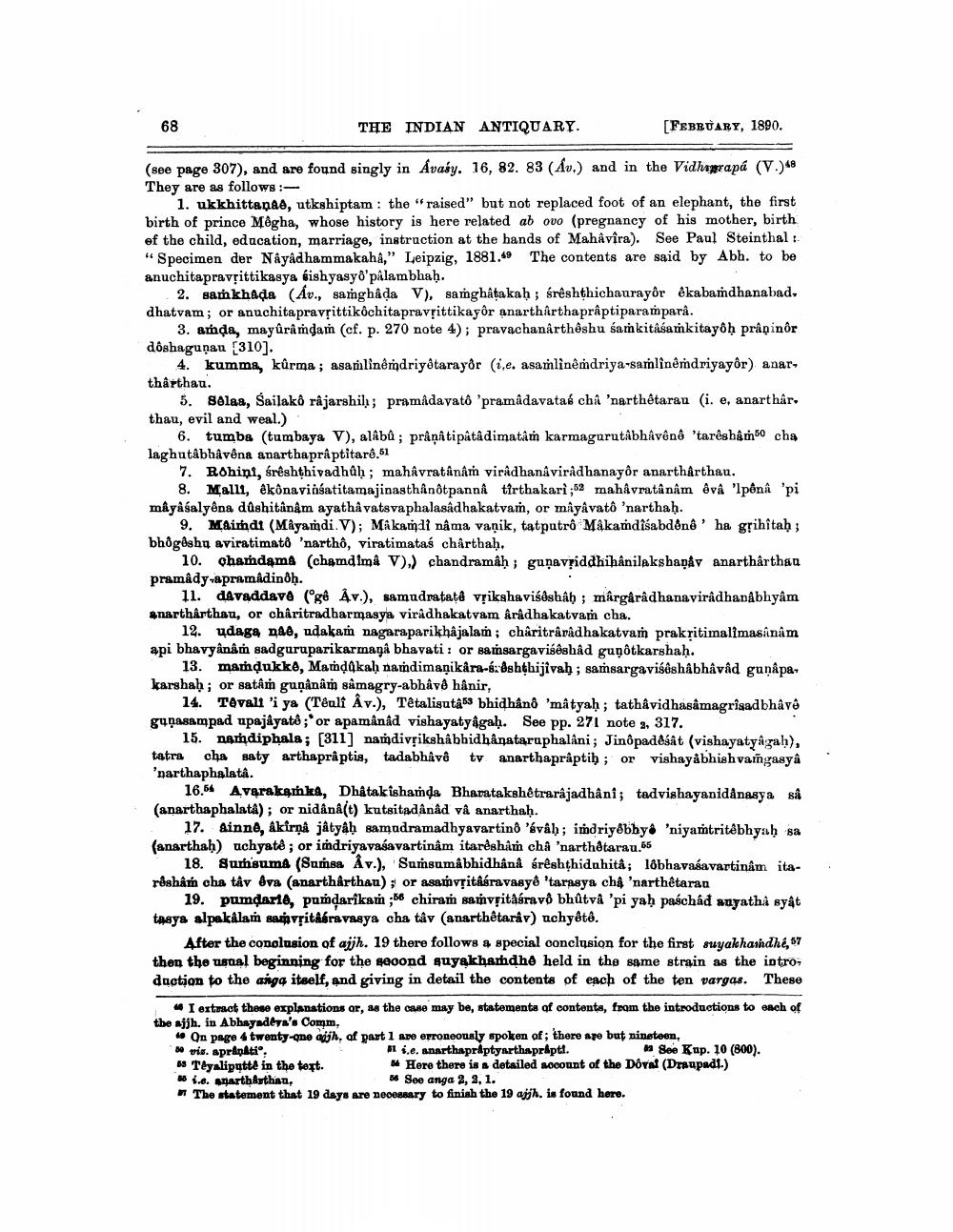________________
68
THE INDIAN ANTIQUARY.
[FEBRUARY, 1890.
(see page 307), and are found singly in Avasy. 16, 82. 83 (Av.) and in the Vidharapá (V.) 48 They are as follows:
1. ukkhittaņas, utkshiptam : the "raised" but not replaced foot of an elephant, the first birth of prince Mégha, whose history is here related ab ovo (pregnancy of his mother, birth ef the child, education, marriage, instruction at the hands of MahÂvira). See Paul Steinthal :. "Specimen der Náyâdhammakaha," Leipzig, 1881.9 The contents are said by Abh. to be anuchitapravșittikasya bishyasyo'palambhah.
2. sarkhada (Av., samghada V), samghatakah, śrêshthichaurayôr ekabamdhanabad, dhatvam; or anuchitapravșittikôchitapravrittikayôr anarthârthaprâptiparamparà.
3. amda, mayûrâmdam (cf. p. 270 note 4); pravachanarthêshu sam kitasamkitayôh prâpinor dôshagunan [310].
4. kumma, kůrma; asanlinêrdriyêtarayôr (i.e. asamlinêmdriya-samlînêmdriyayôr) anar, thârthau.
5. Solaa, Sailako râjarshil; pramadavato 'pramâdavatas cha 'narthêtarau (i. e, anarthår. thau, evil and weal.)
6. tumba (tumbaya V), alábû; pråņâtipâtâdimatâm karmagurutâbhâvênê 'tarëshậm cha laghutâbhâvêna anarthapraptitar8.61
7. Rohini, srêshthivadhah ; mahÂvratânâm virâdhanåviradhanayôr anarthârthau.
8. Malli, êkônaviasatitamajinasthânôtpanna tirthakari ;62 mahåvratâ nám évå 'lpona 'pi mâyâśalyena důshitînêm ayatha vatsvaphalasadhakatvam, or mâyâvatô 'narthah.
9. Maimdi (Mayamdi. V); Makami nama vaņik, tatputrô Måkamdisabdênê' ha grihîtah; bhôgðghų aviratimato 'narthô, viratimataś charthah.
10. chandama (chamd ima )) chandramáh; guņavriddhihanilakshapåv anarthârthau pramady-apramadinh.
11. dAvaddave (g8 Av.), samudratatê vșikshaviśdshah ; märgårådhanaviradhanabhyam snarthårthan, or charitradharmasya viradhakatvam Aradha katvam cha.
12. udaga nae, adakam nagaraparikhâjalam; châritrârâdhakatvam prakritimallmasanam api bhavyânâm sadguruparikarmaga bhavati: or samsargavišdshåd guņôtkarshah.
13. mamdukke, Mandgkah namdimaņikåra-éz8shthijivah ; samsargaviśôshâbhâvâd ganapakarshah; or satâm gunanam samagry-abhävd hånir,
14. Tavall 'i ya (Téuli Av.), Têtaligutâ53 bhidhậno 'matyah; tathậvidhasamagrisadbhave gunasampad upajáyatô;'or apamânad vishayatyagah. See pp. 271 note 3, 317.
15. namdiphala; (311] namdivrikshâbhidhånataruphalâni; Jinopadesát (vishayatyagah), tatra cha saty arthapraptis, tadabhavê tv anarthapraptih; or vishayabhish vamgasya 'narthaphalata.
16.64 Avarakamka, Dhátakishanda Bharatakshetrarajadhâni; tadvishayanidánasya så (anarthaphalata); or nidåna(t) kutsitadânád va anarthah.
17. Ainne, Akirņå jâtyah samudramadhyavartinð 'évâh; indriydbhy 'niyamtritêbhyah sa (anarthah) uchyatd; or imdriyavasavartinâm itaréshán chi 'narthdtarau.65
18. Sumsuma (Sumsa Av.), Sumsumâbhidhânå śrêshthiduhita; lobhavasavartinam ita réshâń cha táv éva (anarthårthau); or asamvřitásra vasyê 'tarasya chů 'narthêtaran
19. pumdario, pundarikam ;56 chiram samvritásravo bhätvå 'pi yah paschad anyathả syật tmaya alpakålam samvritabravasya cha tâv (anarthêtaráv) uchyôtô.
After the conclusion of aih. 19 there follows a special conclusion for the first suyakhandhé, 57 then the usual beginning for the second guyakhardhe held in the same strain as the intro daction to the ange itself, and giving in detail the contents of each of the ten vargas. These
:
4 I extract these explanations or, as the case may be, statements of contents, from the introductions to each of the ajjh, in Abhayadera's Comm,
4. On page 4 twenty-one adjh, of part 1 Ape erroneously spoken of; there apo but nineteen. - vis. apranatio, 11 s.e. anarthapråptyarthaprapti.
See Kup. 10 (800). Téyalipatte in the text.
Here there is a detailed account of the Dôral (Draupadl.) 55 1.. Anarth&sthan,
66 Soe anga 2, 2, 1. The statement that 19 days are necessary to finish the 19 aph. is found here.




